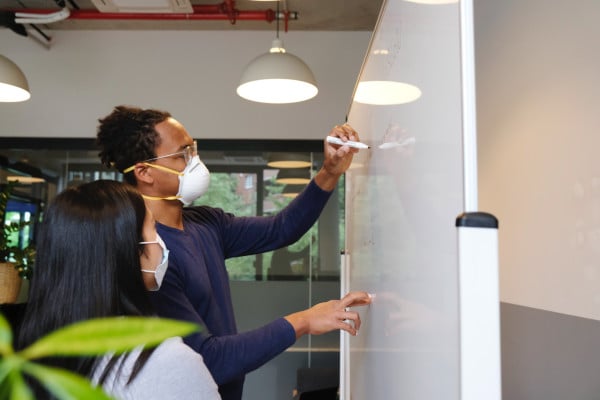How to make hybrid working a success for your teams (5 tips)
As a result of the pandemic, working styles have changed for good. There's more of an emphasis on flexibility, with many companies adopting a hybrid approach to work. So, here are our top tips to help you and your teams make it a success, no matter where they're based.
Remote working became the norm in 2020 as most offices closed their doors due to the pandemic. This year we're seeing more and more businesses introduce a hybrid working model for their staff. But with new and unfamiliar ways of working come challenges and obstacles to overcome. So, that's why we've collated our five top tips to help your company transition to a hybrid working style smoothly and effectively, without compromising on productivity, creativity or employee wellbeing and engagement.
What is hybrid working?
So, before we dive into our top tips, what actually is hybrid working? Also known as 'blended' working, hybrid working models allow employees to perform their job roles in various locations throughout the week: in the office, at home, or in another location like a cafe. It's neither an office-first nor a remote-first environment, but a balanced mix of the two where employees can work some days in a central office and other days elsewhere, if they choose.
Flexibility, trust and adaptability are key components of hybrid working, which is the route many companies, big and small, are taking out of the pandemic. In fact, 43 out of 50 of the UK's biggest employers have said that they don't plan on bringing back staff to the office full-time.
So, what are the advantages of hybrid working?
Over the past year and a half, many employees have experienced working from home for the first time. Some have struggled, while others have flourished. By offering a hybrid model, employees can choose what works best for them, whether that's being in an office full-time, or having two or three days working from home each week.
Rather than an office-first or remote-first style of working, hybrid working allows for a more flexible approach to work, accomodating the needs of more employees and their lifestyles.
Are there any disadvantages of hybrid working?
Hybrid working is new to a lot of companies and it requires a different set-up to the traditional office-centric approach. So, without proper preparation, it can be tricky to get things right for your teams. Whether it's the wrong tech or accidentally leaving certain colleagues out of important conversations, hybrid working doesn't come without its challenges. So, that's why we've put together five top tips to help support you along the way.
How to make hybrid working a success for your teams (5 tips)
1. Get the tech right

Tech helped many companies get through the pandemic, with widespread remote working becoming the norm. So, it's clear that good tech is what we need to thrive in the 'next normal'. Getting it right can be tricky, though.
With teams distributed across the head office and remotely, the right tech can help bring them together, foster creativity and make hybrid working a success. First things first, everyone should have a laptop with a decent webcam and microphone. That way they can carry it with them from meeting to meeting, office to home. A good set of headphones will also come in handy and reduce feedback from others in the room!
For one-to-one meetings where one person is in the office and the other is at home, call cubicles are a great addition to the workplace. By having a small room or cubicle for making calls, both parties can video call each other in privacy, without disturbing other team members in the office.
For team meetings or company-wide meetings, the tech set-up may prove a little trickier when some participants are in the office and others are working remotely. But it's certainly not impossible. In fact, with the right tech setup, your hybrid meetings can run smoothly and effectively.
There are multiple ways to achieve this, whether everyone dials in on their laptop - in and out of the office - or you set up cameras facing presentation screens for those who are remote. One thing's for certain, you'll need to get a high-quality conference microphone so that remote workers can hear their in-office colleagues clearly. You'll also need a good set of speakers so that in-office workers can hear their remote colleagues well too.
2. Plan ahead & find your team's rhythm
It's likely that not everyone in your team will want to work in the office or at home for the same number of days, but it's important to find at least one or two days a week that works best for everyone. You could make that the same day every week - say a Monday - or rotate the day each week to mix things up!
Office hours should also be flexible so that team members can avoid commuting in rush hour if they want to. So, be sure to arrange team meetings at a time when everyone will be in - nearer to midday is probably best.
Soon enough your team will find their rhythm and hybrid working will feel like the norm.
3. Make the most of your time together

When your team is together in the office, make sure to use that time effectively and efficiently. It shouldn't be a time for everyone to sit down at their own desks in silence. Instead use the office as a space for collaborating, bonding and creativity.
So, arrange important meetings or brainstorming sessions for the days you're all together and use work-from-home days to take actions and get into the zone.
Remember, that sometimes getting everyone together in the same room might not be possible, so always accommodate those who are still working remotely.
4. Adapt and improve your communication skills
Being in the office is great for collaboration and idea generation, but you have to be careful not to leave remote workers out of the conversation.
Firstly, set up a regular meeting with your remote co-workers to check in with them, talk about any concerns and also socialise! Without natural 'water cooler' moments, it's important to actively create them. You could also arrange a short morning 'stand-up' with all members of the team, in and out of the office, to go through your daily to-dos, work through blockers and have a bit of a chit-chat.
Outside of those meetings, if you have a really great conversation with your in-office colleagues about an upcoming project, be sure to share the key takeaways with any remote workers who are also involved in that project - whether that's by jumping on a video call or messaging them via your company intranet. With some people in the office and others at home, sometimes it can be easy for certain voices to go unheard. You can avoid this by actively asking each team member's opinion in meetings.
Finally, when many conversations happen via instant messenger or email, it can be really easy to misinterpret or overthink them as you can't rely on the sender's body language or tone of voice. It's always best to assume positive intent unless they say otherwise, but if you're still unsure, you could arrange a short video conversation to iron out any misunderstandings.
5. Make work perks equal for both remote and in-office teams

In the past, work perks were pretty office-centric: team lunches, office yoga, heading to the local pub for Friday drinks. But now things are different - and work perks need to be too. In order to keep all team members engaged, you have to treat them equally.
Thankfully, at Just Eat for Business our flexible food solutions are perfect for hybrid teams. You can order tasty meals for your in-office teams, choosing from over 600 top restaurants and caterers, while also treating your remote co-workers to delicious food boxes or Just Eat gift cards. Click the 'Contact Us' button below to make an enquiry!
Other than providing tasty food perks to your hybrid teams, you can offer other workplace benefits that suit both, like:
- Gym memberships
- Healthcare
- Flexible parental leave
- Volunteering opportunities
- Office yoga/meditation/exercise classes that are also streamed online
- In-person and virtual celebrations and parties
- Sending sweet treats to colleagues on their birthdays
- And lots, lots more - just get creative!
We hope you found our hybrid working tips useful and we wish you good luck!
At Just Eat for Business, we're on a mission to make working lives better, whether that's in the office or while teams work from home. Our flexible food solutions are set up to make hybrid work perks as simple and exciting as possible! So, if you want to treat both your in-office and remote workers to something tasty, don't hesitate to get in touch!
Subscribe to the blog
New to Just Eat for Business?
We bring the UK's best restaurants into your office. No fuss. No hassle. And all for the same price as going direct.
Sign up